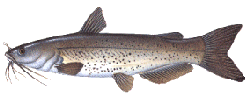
Catfish

The channel catfish is considered the bread and butter fish of most fishermen. Millions are stocked and caught each year. Channel cats are native to nearly all streams and rivers, and they have been stocked in most reservoirs, lakes and ponds. The channel cat has a deeply forked tail, barbels, or whiskers, around the mouth and most smaller fish have silvery sides with black spots. The anal fin is rounded and has less than 30 supporting rays. Tolerant of muddy or murky water, the channel cat is known as a night feeder, detecting the odor of baits with its sensitive whiskers.

The blue cat is native to most rivers and is not nearly as widespread as the channel or Flathead catfish. Reports from the turn of the century document blue cats weighing more than 150 pounds. While having a forked tail similar to the channel cat, the blue cat is often pale in color, sometimes nearly white. It is never spotted as the channel cat sometimes is, and it has a noticeably humped back. The key difference, however, is the anal fin, which is longer on the blue, with 30-35 supporting rays.

The flathead catfish is a highly sought after trophy fish. Native to most of rivers, Flathead has also adapted well to reservoirs. Flatheads are generally much larger than channel cats, have a broad, flat head as the name implies and have a square tail as opposed to the forked tail of the channel cat. Often called yellow cats or appaloosa cats, flatheads vary in color, depending on the water they are taken from, ranging from a mottled brown to a pale yellow. Many of the larger flatheads are caught on bank or trot lines, and they are selective in their eating habits, requiring live bait.
There are actually two species of bullheads, the black and the yellow. The black and yellow bullhead is common in most streams and ponds with the yellow being less commonly found. The yellow bullhead is dark-green or yellow-green with a white or yellowish belly. The black bullhead is usually larger than the yellow, and the barbels on the lower jaw are darker than the surrounding skin. The yellow's barbels on the lower jaw are white. Bullheads are sometimes thought of as problem fish and can overpopulate and stunt under some conditions. However, they are great fish for young anglers, biting readily on worms, liver and dead bait. Tolerant of muddy water, the bullhead is usually the last fish to succumb to drought conditions.